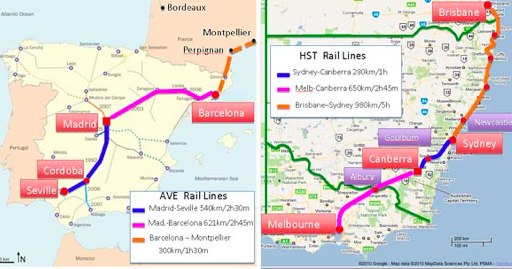The Null Device
2010/3/28
As China expands its high-speed railway network and even the US, ideological home of the automobile, starts planning its own, people are once again talking about the prospect of high-speed rail in Australia. This article, for example, points out that the distances between Melbourne, Canberra and Sydney are comparable to distances in Spain, whose high-speed rail system has been spectacularly successful, and that the costs of building such a system would be a lot lower than the intimidating figures tossed around by naysayers:
But the best model for Australia to follow is Spain's, which has built two HST lines of 1161 kilometres linking Madrid to Seville (540 kilometres, opened 18 years ago) and Barcelona (630 kilometres). These distances, and as it happens the total population, served by the trains is quite comparable to the Australian SCM axis (see graphic). Based on the current French estimate of Euro 10 million/km ($A15 million/km) to build those lines today would be about $A17.4 billion; even allowing several billions more for stations and train sets it would be a struggle to spend even half the fictional $60 billion, perhaps $20-25 billion.
Contrary to misinformation concerning high speed rail in Australia, it is logistically, economically and even politically feasible. Australians are now receptive to such nation-building infrastructure, if only our politicians had the courage to sell the vision and could think beyond one or two electoral cycles. Economically it stacks up against continued spending on highway projects or hugely expensive airport upgrades, or the interminable wrangling over Sydney's phantom second airport. Dismissing the strategy of an expanded Canberra airport or a new one shifted closer to Sydney served by a 30-50 minute HST journey to the heart of Sydney and Canberra, is the same tired defeatism we have had for decades.The high-speed rail route would follow the existing Melbourne-Sydney route from Melbourne through to Albury, thence diverging eastward, passing through Canberra and Goulburn. A one-way trip between Melbourne and Sydney would take under five hours. (An eventual extension to Brisbane would theoretically take another five hours to traverse, though I imagine that they'd have to straighten the route out considerably from the existing one to achieve this; part of the high-speed rail formula is straighter tracks than conventional railways have.)
One interesting effect of high-speed rail in Australia would probably be the development of a commuter belt outside of the major cities, and corresponding relief for housing shortages (which are particularly acute in Melbourne these days). If Albury is 90 minutes away from Melbourne by train, it is just about conceivable that people might commute in from there. (The town of Seymour, on the existing Melbourne-Albury line, would be a mere 30-40 minutes from Melbourne by high-speed rail, and would be well poised to become a base for commuting to Melbourne.) Goulburn (and, eventually, Newcastle) could do the same for Sydney. There are precedents; one effect of the TGV lines in France is that towns on lines going to Paris have become parts of Paris' commuter belt.
Australia is probably better poised to develop large infrastructure projects than recession-hit Europe, currently floating on the (largely Chinese-fuelled) resources boom. Of course, knowing Australia (a place where short-termism and apathy rule even more than elsewhere), chances are high-speed rail will remain in the too-hard basket until the price of oil suddenly puts and end to $65 Virgin Blue flights, taking everybody by surprise because, while they might have known that oil prices were going to rise, they didn't expect it to actually affect them.
Security researchers are now working on ways of generating machine code that looks like English-language text (PDF).
In this paper we revisit the assumption that shellcode need be fundamentally different in structure than non-executable data. Specifically, we elucidate how one can use natural language generation techniques to produce shellcode that is superficially similar to English prose. We argue that this new development poses significant challenges for inline payloadbased inspection (and emulation) as a defensive measure, and also highlights the need for designing more efficient techniques for preventing shellcode injection attacks altogether.The code is generated by a language engine which selects fragments of text, Markov-chain-fashion, from a large source (such as Wikipedia or the Gutenberg Project). It looks like the random gibberish spammers pad their emails out with, though if executed, functions as x86 machine code. (Rather inefficient machine code, with a lot of jumps and circumlocutions to fit the constraints of looking like English, but good enough to sneak exploits through in.) Below is an example of some code thus disguised:
A piece in Vice Magazine on odd and unfortunate things from the world of fashion, from the obvious (the ever-escalating arms races between shock value and desensitisation, iPhones as dandruff magnets, the increasing ordeal of air travel during the Long Siege taking its toll on sartorial standards) to the more unusual (fake human flesh is apparently a fabric these days):
And then there are the military applications. What happens if the Taliban or the armed forces of Iran or Kim Jong-il’s Korean People’s Army gets hold of SkinBag’s URL? Any military force outfitted in human skins would make the Old Norse berserkers pale in comparison. Could any country on earth face down an army of Ed Geins?
A German website now offers the “Get Naked Bikini”..., a two-piece water-soluble swimsuit that allegedly falls apart after three minutes of swimming... Although this combination of polymers is found in most water-resistant swimsuits, the dubious product has still managed to enrage many sensible Europeans with its overtones of male revenge fantasy (the comparably priced men’s “Get Naked Pants” haven’t yet made the news).

